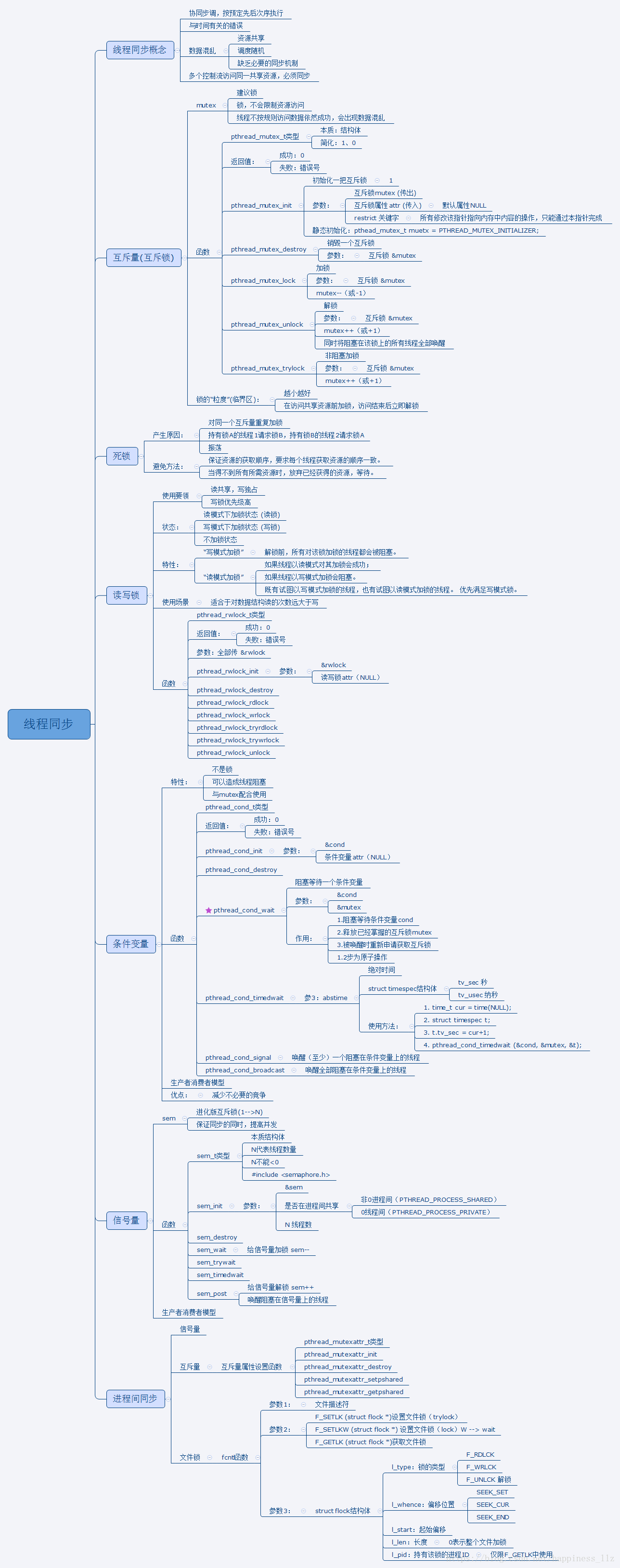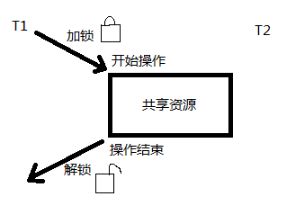一、整体大纲

二、线程同步
1. 同步概念
所谓同步,即同时起步,协调一致。不同的对象,对“同步”的理解方式略有不同。如,设备同步,是指在两个设备之间规定一个共同的时间参考;数据库同步,是指让两个或多个数据库内容保持一
致,或者按需要部分保持一致;文件同步,是指让两个或多个文件夹里的文件保持一致等等。
而编程中、通信中所说的同步与生活中大家印象中的同步概念略有差异。“同”字应是指协同、协助、互相配合。主旨在协同步调,按预定的先后次序运行。
2. 线程同步
(1)线程同步概念
同步即协同步调,按预定的先后次序运行。
线程同步,指一个线程发出某一功能调用时,在没有得到结果之前,该调用不返回。同时其它线程为保证数据一致性,不能调用该功能。
举例1: 银行存款 5000。柜台,折:取3000;提款机,卡:取 3000。剩余:2000
举例2: 内存中100字节,线程T1欲填入全1, 线程T2欲填入全0。但如果T1执行了50个字节失去cpu,T2执行,会将T1写过的内容覆盖。当T1再次获得cpu继续 从失去cpu的位置向后写入1,当执
行结束,内存中的100字节,既不是全1,也不是全0。
产生的现象叫做“与时间有关的错误”(time related)。为了避免这种数据混乱,线程需要同步。
“同步”的目的,是为了避免数据混乱,解决与时间有关的错误。实际上,不仅线程间需要同步,进程间、信号间等等都需要同步机制。
因此,所有“多个控制流,共同操作一个共享资源”的情况,都需要同步。
(2)数据混乱原因
1)资源共享(独享资源则不会)
2)调度随机(意味着数据访问会出现竞争)
3)线程间缺乏必要的同步机制。
以上3点中,前两点不能改变,欲提高效率,传递数据,资源必须共享。只要共享资源,就一定会出现竞争。只要存在竞争关系,数据就很容易出现混乱。
所以只能从第三点着手解决。使多个线程在访问共享资源的时候,出现互斥。
3. 实现线程同步
(1)互斥量mutex
Linux中提供一把互斥锁mutex(也称之为互斥量)。
每个线程在对资源操作前都尝试先加锁,成功加锁才能操作,操作结束解锁。
资源还是共享的,线程间也还是竞争的,
但通过“锁”就将资源的访问变成互斥操作,而后与时间有关的错误也不会再产生了。

但应注意:同一时刻,只能有一个线程持有该锁。
当A线程对某个全局变量加锁访问,B在访问前尝试加锁,拿不到锁,B阻塞。C线程不去加锁,而直接访问该全局变量,依然能够访问,但会出现数据混乱。
所以,互斥锁实质上是操作系统提供的一把“建议锁”(又称“协同锁”),建议程序中有多线程访问共享资源的时候使用该机制。但,并没有强制限定。
因此,即使有了mutex,如果有线程不按规则来访问数据,依然会造成数据混乱。
1)主要函数
pthread_mutex_init函数 pthread_mutex_destroy函数 pthread_mutex_lock函数 pthread_mutex_trylock函数 pthread_mutex_unlock函数 以上5个函数的返回值都是:成功返回0, 失败返回错误号。 pthread_mutex_t 类型,其本质是一个结构体。为简化理解,应用时可忽略其实现细节,简单当成整数看待。 pthread_mutex_t mutex; 变量mutex只有两种取值1、0。
- pthread_mutex_init函数
初始化一个互斥锁(互斥量) ---> 初值可看作1
int pthread_mutex_init(pthread_mutex_t *restrict mutex, const pthread_mutexattr_t *restrict attr);
参1:传出参数,调用时应传 &mutex
restrict关键字:只用于限制指针,告诉编译器,所有修改该指针指向内存中内容的操作,只能通过本指针完成。不能通过除本指针以外的其他变量或指针修改。
参2:互斥量属性。是一个传入参数,通常传NULL,选用默认属性(线程间共享)。 参APUE.12.4同步属性
静态初始化:如果互斥锁 mutex 是静态分配的(定义在全局,或加了static关键字修饰),可以直接使用宏进行初始化。e.g. pthead_mutex_t muetx = PTHREAD_MUTEX_INITIALIZER;
动态初始化:局部变量应采用动态初始化。e.g. pthread_mutex_init(&mutex, NULL)
- pthread_mutex_destroy函数
销毁一个互斥锁
int pthread_mutex_destroy(pthread_mutex_t *mutex);
- pthread_mutex_lock函数
加锁。可理解为将 mutex--(或-1)
int pthread_mutex_lock(pthread_mutex_t *mutex);
- pthread_mutex_unlock函数
解锁。可理解为将mutex ++(或+1)
int pthread_mutex_unlock(pthread_mutex_t *mutex);
- pthread_mutex_trylock函数
尝试加锁
int pthread_mutex_trylock(pthread_mutex_t *mutex);
2)加锁与解锁
lock与unlock:
lock尝试加锁,如果加锁不成功,线程阻塞,阻塞到持有该互斥量的其他线程解锁为止。
unlock主动解锁函数,同时将阻塞在该锁上的所有线程全部唤醒,至于哪个线程先被唤醒,取决于优先级、调度。默认:先阻塞、先唤醒。
例如:T1 T2 T3 T4 使用一把mutex锁。T1加锁成功,其他线程均阻塞,直至T1解锁。T1解锁后,T2 T3 T4均被唤醒,并自动再次尝试加锁。
可假想mutex锁 init成功初值为1。 lock 功能是将mutex--。 unlock将mutex++
lock与trylock:
lock加锁失败会阻塞,等待锁释放。
trylock加锁失败直接返回错误号(如:EBUSY),不阻塞。

1 #include <stdio.h> 2 #include <unistd.h> 3 #include <pthread.h> 4 #include <string.h> 5 6 pthread_mutex_t mutex; 7 8 void *thr(void *arg) 9 { 10 while(1) 11 { 12 pthread_mutex_lock(&mutex); 13 printf("hello world "); 14 sleep(30); 15 pthread_mutex_unlock(&mutex); 16 } 17 18 return NULL; 19 } 20 21 int main() 22 { 23 pthread_mutex_init(&mutex, NULL); 24 pthread_t tid; 25 pthread_create(&tid, NULL, thr, NULL); 26 27 sleep(1); 28 29 while (1) 30 { 31 int ret = pthread_mutex_trylock(&mutex); 32 if (ret > 0) 33 { 34 printf("ret = %d, errmsg = %s ", ret, strerror(ret)); 35 } 36 sleep(1); 37 } 38 39 return 0; 40 }
3)加锁步骤测试
看如下程序:该程序是非常典型的,由于共享、竞争而没有加任何同步机制,导致产生于时间有关的错误,造成数据混乱:

1 #include <stdio.h> 2 #include <unistd.h> 3 #include <pthread.h> 4 #include <stdlib.h> 5 6 void *thr1(void *arg) 7 { 8 while(1) 9 { 10 printf("hello"); 11 sleep(rand()%3); 12 printf("world "); 13 sleep(rand()%3); 14 } 15 } 16 17 void *thr2(void *arg) 18 { 19 while(1) 20 { 21 printf("HELLO"); 22 sleep(rand()%3); 23 printf("WORLD "); 24 sleep(rand()%3); 25 } 26 } 27 28 int main() 29 { 30 pthread_t thr[2]; 31 pthread_create(&thr[0], NULL, thr1, NULL); 32 pthread_create(&thr[1], NULL, thr2, NULL); 33 34 pthread_join(thr[0], NULL); 35 pthread_join(thr[1], NULL); 36 37 return 0; 38 }
练习:修改该程序,使用mutex互斥锁进行同步。
定义全局互斥量,初始化init(&m, NULL)互斥量,添加对应的destry
两个线程while中,两次printf前后,分别加lock和unlock
将unlock挪至第二个sleep后,发现交替现象很难出现。
线程在操作完共享资源后本应该立即解锁,但修改后,线程抱着锁睡眠。睡醒解锁后又立即加锁,这两个库函数本身不会阻塞。
所以在这两行代码之间失去cpu的概率很小。因此,另外一个线程很难得到加锁的机会。

1 #include <stdio.h> 2 #include <unistd.h> 3 #include <pthread.h> 4 #include <stdlib.h> 5 6 pthread_mutex_t mutex = PTHREAD_MUTEX_INITIALIZER; 7 8 void *thr1(void *arg) 9 { 10 while(1) 11 { 12 //先上锁 13 pthread_mutex_lock(&mutex); //加锁当有线程已经枷锁的时候,阻塞 14 printf("hello"); 15 sleep(rand()%3); 16 printf("world "); 17 //sleep(rand()%3); 18 //解锁 19 pthread_mutex_unlock(&mutex); 20 sleep(rand()%3); 21 } 22 } 23 24 void *thr2(void *arg) 25 { 26 while(1) 27 { 28 //上锁 29 pthread_mutex_lock(&mutex); 30 printf("HELLO"); 31 sleep(rand()%3); 32 printf("WORLD "); 33 //sleep(rand()%3); 34 //解锁 35 pthread_mutex_unlock(&mutex); 36 sleep(rand()%3); 37 } 38 } 39 40 int main() 41 { 42 pthread_t thr[2]; 43 pthread_create(&thr[0], NULL, thr1, NULL); 44 pthread_create(&thr[1], NULL, thr2, NULL); 45 46 pthread_join(thr[0], NULL); 47 pthread_join(thr[1], NULL); 48 49 return 0; 50 }
结论:
在访问共享资源前加锁,访问结束后立即解锁。锁的“粒度”应越小越好。
4)死锁
- 线程试图对同一个互斥量A加锁两次。
- 线程1拥有A锁,请求获得B锁;线程2拥有B锁,请求获得A锁
练习:编写程序,实现上述两种死锁现象。
(2)读写锁
1)概念
与互斥量类似,但读写锁允许更高的并行性。其特性为:写独占,读共享。
2)读写锁状态
一把读写锁具备三种状态:
a. 读模式下加锁状态 (读锁)
b. 写模式下加锁状态 (写锁)
c. 不加锁状态
3)读写锁特性
- 读写锁是“写模式加锁”时, 解锁前,所有对该锁加锁的线程都会被阻塞。
- 读写锁是“读模式加锁”时, 如果线程以读模式对其加锁会成功;如果线程以写模式加锁会阻塞。
- 读写锁是“读模式加锁”时, 既有试图以写模式加锁的线程,也有试图以读模式加锁的线程。那么读写锁会阻塞随后的读模式锁请求。优先满足写模式锁。读锁、写锁并行阻塞,写锁优先级高。
读写锁也叫共享-独占锁。当读写锁以读模式锁住时,它是以共享模式锁住的;当它以写模式锁住时,它是以独占模式锁住的。写独占、读共享。
读写锁非常适合于对数据结构读的次数远大于写的情况。
3)主要函数
pthread_rwlock_init函数
pthread_rwlock_destroy函数
pthread_rwlock_rdlock函数
pthread_rwlock_wrlock函数
pthread_rwlock_tryrdlock函数
pthread_rwlock_trywrlock函数
pthread_rwlock_unlock函数
以上7 个函数的返回值都是:成功返回0, 失败直接返回错误号。
pthread_rwlock_t类型 用于定义一个读写锁变量。
pthread_rwlock_t rwlock;
- pthread_rwlock_init函数
初始化一把读写锁
int pthread_rwlock_init(pthread_rwlock_t *restrict rwlock, const pthread_rwlockattr_t *restrict attr);
参2:attr表读写锁属性,通常使用默认属性,传NULL即可。
- pthread_rwlock_destroy函数
销毁一把读写锁
int pthread_rwlock_destroy(pthread_rwlock_t *rwlock);
- pthread_rwlock_rdlock函数
以读方式请求读写锁。(常简称为:请求读锁)
int pthread_rwlock_rdlock(pthread_rwlock_t *rwlock);
- pthread_rwlock_wrlock函数
以写方式请求读写锁。(常简称为:请求写锁)
int pthread_rwlock_wrlock(pthread_rwlock_t *rwlock);
- pthread_rwlock_unlock函数
解锁
int pthread_rwlock_unlock(pthread_rwlock_t *rwlock);
- pthread_rwlock_tryrdlock函数
非阻塞以读方式请求读写锁(非阻塞请求读锁)
int pthread_rwlock_tryrdlock(pthread_rwlock_t *rwlock);
- pthread_rwlock_trywrlock函数
非阻塞以写方式请求读写锁(非阻塞请求写锁)
int pthread_rwlock_trywrlock(pthread_rwlock_t *rwlock);
4)读写锁示例
看如下示例,同时有多个线程对同一全局数据读、写操作。

1 #include <stdio.h> 2 #include <unistd.h> 3 #include <pthread.h> 4 5 int begin_num = 1000; 6 pthread_rwlock_t rwlock = PTHREAD_RWLOCK_INITIALIZER; 7 8 void *thr_write(void *arg) 9 { 10 while(1) 11 { 12 pthread_rwlock_wrlock(&rwlock); 13 printf("funcname = %s, self = %lu, begin_num = %d ", __FUNCTION__, pthread_self(), begin_num++); 14 usleep(2000); //模拟占用时间 15 pthread_rwlock_unlock(&rwlock); 16 usleep(3000); //防止释放锁之后又去抢 17 } 18 } 19 20 void *thr_read(void *arg) 21 { 22 while(1) 23 { 24 pthread_rwlock_wrlock(&rwlock); 25 printf("funcname = %s, self = %lu, begin_num = %d ", __FUNCTION__, pthread_self(), begin_num); 26 usleep(2000); //模拟占用时间 27 pthread_rwlock_unlock(&rwlock); 28 usleep(2000); //防止释放锁之后又去抢 29 } 30 } 31 int main() 32 { 33 int n = 8, i = 0; 34 pthread_t tid[8]; //5-read, 3-write 35 for (i = 0; i < 5; i++) 36 { 37 pthread_create(&tid[i], NULL, thr_read, NULL); 38 } 39 40 for (; i < n; i++) 41 { 42 pthread_create(&tid[i], NULL, thr_write, NULL); 43 } 44 45 for (i = 0; i < n; i++) 46 { 47 pthread_join(tid[i], NULL); 48 } 49 50 return 0; 51 }
读写锁场景练习:
a. 线程A加写锁成功,线程B请求读锁
线程B阻塞
b. 线程A持有读锁,线程B请求写锁
线程B阻塞
c. 线程A持有读锁,线程B请求读锁
B加锁成功
d. 线程A持有读锁,然后线程B请求写锁,然后线程C请求读锁
BC阻塞
A释放后,B加锁
B释放后,C加锁
e. 线程A持有写锁,然后线程B请求读锁,然后线程C请求写锁
BC阻塞
A释放,C加锁
C释放,B加锁
(3)条件变量
1)概念
条件变量本身不是锁!但它也可以造成线程阻塞。通常与互斥锁配合使用。给多线程提供一个会合的场所。
2)主要应用函数
pthread_cond_init函数
pthread_cond_destroy函数
pthread_cond_wait函数
pthread_cond_timedwait函数
pthread_cond_signal函数
pthread_cond_broadcast函数
以上6 个函数的返回值都是:成功返回0, 失败直接返回错误号。
pthread_cond_t类型 用于定义条件变量
pthread_cond_t cond;
- pthread_cond_init函数
初始化一个条件变量
int pthread_cond_init(pthread_cond_t *restrict cond, const pthread_condattr_t *restrict attr);
参2:attr表条件变量属性,通常为默认值,传NULL即可
也可以使用静态初始化的方法,初始化条件变量:
pthread_cond_t cond = PTHREAD_COND_INITIALIZER;
- pthread_cond_destroy函数
销毁一个条件变量
int pthread_cond_destroy(pthread_cond_t *cond);
- pthread_cond_wait函数
阻塞等待一个条件变量
int pthread_cond_wait(pthread_cond_t *restrict cond, pthread_mutex_t *restrict mutex);
函数作用:
a. 阻塞等待条件变量cond(参1)满足
b. 释放已掌握的互斥锁(解锁互斥量)相当于pthread_mutex_unlock(&mutex);
a.b.两步为一个原子操作。
c. 当被唤醒,pthread_cond_wait函数返回时,解除阻塞并重新申请获取互斥锁pthread_mutex_lock(&mutex);
- pthread_cond_timedwait函数
限时等待一个条件变量
int pthread_cond_timedwait(pthread_cond_t *restrict cond, pthread_mutex_t *restrict mutex, const struct timespec *restrict abstime);
参3: 参看man sem_timedwait函数,查看struct timespec结构体。
struct timespec { time_t tv_sec; /* seconds */ 秒 long tv_nsec; /* nanosecondes*/ 纳秒 }
形参abstime:绝对时间。
如:time(NULL)返回的就是绝对时间。而alarm(1)是相对时间,相对当前时间定时1秒钟。
struct timespec t = {1, 0};
pthread_cond_timedwait (&cond, &mutex, &t); 只能定时到 1970年1月1日 00:00:01秒(早已经过去)
正确用法:
time_t cur = time(NULL); 获取当前时间。 struct timespec t; 定义timespec 结构体变量t t.tv_sec = cur+1; 定时1秒 pthread_cond_timedwait (&cond, &mutex, &t); 传参 参APUE.11.6线程同步条件变量小节 在讲解setitimer函数时我们还提到另外一种时间类型: struct timeval { time_t tv_sec; /* seconds */ 秒 suseconds_t tv_usec; /* microseconds */ 微秒 };
- pthread_cond_signal函数
唤醒至少一个阻塞在条件变量上的线程
int pthread_cond_signal(pthread_cond_t *cond);
- pthread_cond_broadcast函数
唤醒全部阻塞在条件变量上的线程
int pthread_cond_broadcast(pthread_cond_t *cond);
3)生产者消费者条件变量模型
线程同步典型的案例即为生产者消费者模型,而借助条件变量来实现这一模型,是比较常见的一种方法。假定有两个线程,一个模拟生产者行为,一个模拟消费者行为。两个线程同时操作一个共
享资源(一般称之为汇聚),生产向其中添加产品,消费者从中消费掉产品。
看如下示例,使用条件变量模拟生产者、消费者问题:

1 #include <stdio.h> 2 #include <unistd.h> 3 #include <pthread.h> 4 #include <stdlib.h> 5 6 int begin_num = 1000; 7 8 pthread_mutex_t mutex = PTHREAD_MUTEX_INITIALIZER; 9 pthread_cond_t cond = PTHREAD_COND_INITIALIZER; 10 11 typedef struct _ProdInfo{ 12 int num; 13 struct _ProdInfo *next; 14 }ProdInfo; 15 16 ProdInfo *Head = NULL; 17 18 void *thr_producter(void *arg) 19 { 20 //负责在链表添加数据 21 while(1) 22 { 23 ProdInfo *prod = malloc(sizeof(ProdInfo)); 24 prod->num = begin_num++; 25 printf("funcname = %s, self = %lu, data = %d ", __FUNCTION__, pthread_self(), prod->num); 26 27 pthread_mutex_lock(&mutex); 28 //add to list 29 prod->next = Head; 30 Head = prod; 31 pthread_mutex_unlock(&mutex); 32 33 //发起通知 34 pthread_cond_signal(&cond); 35 sleep(rand()%3); 36 } 37 38 return NULL; 39 } 40 41 void *thr_consumer(void *arg) 42 { 43 ProdInfo *prod = NULL; 44 45 while(1) 46 { 47 //取链表的数据 48 pthread_mutex_lock(&mutex); 49 //if (Head == NULL) 50 while (Head == NULL) 51 { 52 pthread_cond_wait(&cond, &mutex); //在此之前必须先加锁 53 } 54 prod = Head; 55 Head = Head->next; 56 printf("funcname = %s, self = %lu, data = %d ", __FUNCTION__, pthread_self(), prod->num); 57 pthread_mutex_unlock(&mutex); 58 sleep(rand()%3); 59 free(prod); 60 } 61 62 return NULL; 63 } 64 65 int main() 66 { 67 pthread_t tid[3]; 68 pthread_create(&tid[0], NULL, thr_producter, NULL); 69 pthread_create(&tid[1], NULL, thr_consumer, NULL); 70 pthread_create(&tid[2], NULL, thr_consumer, NULL); 71 72 pthread_join(tid[0], NULL); 73 pthread_join(tid[1], NULL); 74 pthread_join(tid[2], NULL); 75 76 pthread_mutex_destroy(&mutex); 77 pthread_cond_destroy(&cond); 78 79 return 0; 80 }
4)条件变量的优点
相较于mutex而言,条件变量可以减少竞争。
如直接使用mutex,除了生产者、消费者之间要竞争互斥量以外,消费者之间也需要竞争互斥量,但如果汇聚(链表)中没有数据,消费者之间竞争互斥锁是无意义的。有了条件变量机制以后,只有
生产者完成生产,才会引起消费者之间的竞争。提高了程序效率。
(4)信号量
1)概念
进化版的互斥锁(1 --> N)
由于互斥锁的粒度比较大,如果我们希望在多个线程间对某一对象的部分数据进行共享,使用互斥锁是没有办法实现的,只能将整个数据对象锁住。这样虽然达到了多线程操作共享数据时保证数
据正确性的目的,却无形中导致线程的并发性下降。线程从并行执行,变成了串行执行。与直接使用单进程无异。
信号量,是相对折中的一种处理方式,既能保证同步,数据不混乱,又能提高线程并发。
2)主要应用函数
sem_init函数 sem_destroy函数 sem_wait函数 sem_trywait函数 sem_timedwait函数 sem_post函数 以上6 个函数的返回值都是:成功返回0, 失败返回-1,同时设置errno。(注意,它们没有pthread前缀) sem_t类型,本质仍是结构体。但应用期间可简单看作为整数,忽略实现细节(类似于使用文件描述符)。 sem_t sem; 规定信号量sem不能 < 0。头文件 <semaphore.h>
信号量基本操作:
sem_wait:
a. 信号量大于0,则信号量-- (类比pthread_mutex_lock)
b. 信号量等于0,造成线程阻塞
对应 ->
sem_post: 将信号量++,同时唤醒阻塞在信号量上的线程 (类比pthread_mutex_unlock)
但由于sem_t的实现对用户隐藏,所以所谓的++、--操作只能通过函数来实现,而不能直接++、--符号。
信号量的初值,决定了占用信号量的线程的个数。
- sem_init函数
初始化一个信号量
int sem_init(sem_t *sem, int pshared, unsigned int value);
参1:sem信号量
参2:pshared取0用于线程间;取非0(一般为1)用于进程间
参3:value指定信号量初值
- sem_destroy函数
销毁一个信号量
int sem_destroy(sem_t *sem);
- sem_wait函数
给信号量加锁 --
int sem_wait(sem_t *sem);
- sem_post函数
给信号量解锁 ++
int sem_post(sem_t *sem);
- sem_trywait函数
尝试对信号量加锁 -- (与sem_wait的区别类比lock和trylock)
int sem_trywait(sem_t *sem);
- sem_timedwait函数
限时尝试对信号量加锁 --
int sem_timedwait(sem_t *sem, const struct timespec *abs_timeout);
参2:abs_timeout采用的是绝对时间。
定时1秒: time_t cur = time(NULL); 获取当前时间。 struct timespec t; 定义timespec 结构体变量t t.tv_sec = cur+1; 定时1秒 t.tv_nsec = t.tv_sec +100; sem_timedwait(&sem, &t); 传参
3)生产者消费者信号量模型
使用信号量完成线程间同步,模拟生产者,消费者问题。

1 #include <stdio.h> 2 #include <unistd.h> 3 #include <pthread.h> 4 #include <semaphore.h> 5 #include <stdlib.h> 6 7 //blank -- 生产者 8 //xfull -- 消费者 9 sem_t blank, xfull; 10 #define _SEM_CNT_ 5 11 12 int queue[_SEM_CNT_]; //存放生产者数据 13 int begin_num = 100; 14 15 void *thr_producter(void *arg) 16 { 17 int i = 0; 18 while(1) 19 { 20 sem_wait(&blank); //申请资源 blank-- 21 printf("funcname = %s, self = %lu, num = %d ", __FUNCTION__, pthread_self(), begin_num); 22 queue[(i++)%_SEM_CNT_] = begin_num++; 23 sem_post(&xfull); //xfull++ 24 sleep(rand()%3); 25 } 26 27 return NULL; 28 } 29 void *thr_consumer(void *arg) 30 { 31 int i = 0; 32 int num = 0; 33 while(1) 34 { 35 sem_wait(&xfull); 36 num = queue[(i++)%_SEM_CNT_]; 37 printf("funcname = %s, self = %lu, num = %d ", __FUNCTION__, pthread_self(), num); 38 sem_post(&blank); 39 sleep(rand()%3); 40 } 41 42 return NULL; 43 } 44 45 int main() 46 { 47 sem_init(&blank, 0, _SEM_CNT_); 48 sem_init(&xfull, 0, 0); //消费者一开始初始化,默认没有产品 49 50 pthread_t tid[2]; 51 pthread_create(&tid[0], NULL, thr_producter, NULL); 52 pthread_create(&tid[1], NULL, thr_consumer, NULL); 53 54 pthread_join(tid[0], NULL); 55 pthread_join(tid[1], NULL); 56 57 sem_destroy(&blank); 58 sem_destroy(&xfull); 59 60 return 0; 61 }
(5)进程间同步
互斥量mutex
进程间也可以使用互斥锁,来达到同步的目的。但应在pthread_mutex_init初始化之前,修改其属性为进程间共享。mutex的属性修改函数主要有以下几个。
主要应用函数:
pthread_mutexattr_t mattr 类型: 用于定义mutex锁的【属性】 pthread_mutexattr_init函数: 初始化一个mutex属性对象 int pthread_mutexattr_init(pthread_mutexattr_t *attr); pthread_mutexattr_destroy函数: 销毁mutex属性对象 (而非销毁锁) int pthread_mutexattr_destroy(pthread_mutexattr_t *attr); pthread_mutexattr_setpshared函数: 修改mutex属性。 int pthread_mutexattr_setpshared(pthread_mutexattr_t *attr, int pshared); 参2:pshared取值: 线程锁:PTHREAD_PROCESS_PRIVATE (mutex的默认属性即为线程锁,进程间私有) 进程锁:PTHREAD_PROCESS_SHARED
进程间mutex示例:

1 #include <fcntl.h> 2 #include <pthread.h> 3 #include <sys/mman.h> 4 #include <sys/wait.h> 5 6 struct mt{ 7 int num; 8 pthread_mutex_t mutex; 9 pthread_mutexattr_t mutexattr; 10 }; 11 12 int main(void) 13 { 14 int fd, i; 15 struct mt *mm; 16 pid_t pid; 17 18 fd = open("mt_test", O_CREAT | O_RDWR, 0777); 19 ftruncate(fd, sizeof(*mm)); 20 mm = mmap(NULL, sizeof(*mm), PROT_READ|PROT_WRITE, MAP_SHARED, fd, 0); 21 close(fd); 22 unlink("mt_test"); 23 //mm = mmap(NULL, sizeof(*mm), PROT_READ|PROT_WRITE, MAP_SHARED|MAP_ANON, -1, 0); 24 memset(mm, 0, sizeof(*mm)); 25 pthread_mutexattr_init(&mm->mutexattr); //初始化mutex属性对象 26 pthread_mutexattr_setpshared(&mm->mutexattr, PTHREAD_PROCESS_SHARED); //修改属性为进程间共享 27 pthread_mutex_init(&mm->mutex, &mm->mutexattr); //初始化一把mutex琐 28 pid = fork(); 29 if (pid == 0) { 30 for (i = 0; i < 10; i++) { 31 pthread_mutex_lock(&mm->mutex); 32 (mm->num)++; 33 printf("-child----num++ %d ", mm->num); 34 pthread_mutex_unlock(&mm->mutex); 35 sleep(1); 36 } 37 } else if (pid > 0) { 38 for ( i = 0; i < 10; i++) { 39 sleep(1); 40 pthread_mutex_lock(&mm->mutex); 41 mm->num += 2; 42 printf("-parent---num+=2 %d ", mm->num); 43 pthread_mutex_unlock(&mm->mutex); 44 } 45 wait(NULL); 46 } 47 48 pthread_mutexattr_destroy(&mm->mutexattr); //销毁mutex属性对象 49 pthread_mutex_destroy(&mm->mutex); //销毁mutex 50 munmap(mm,sizeof(*mm)); //释放映射区 51 52 return 0; 53 }
(6)文件锁
借助 fcntl函数来实现锁机制。 操作文件的进程没有获得锁时,可以打开,但无法执行read、write操作。
fcntl函数: 获取、设置文件访问控制属性。
int fcntl(int fd, int cmd, ... /* arg */ );
参2:
F_SETLK (struct flock *) 设置文件锁(trylock) F_SETLKW (struct flock *) 设置文件锁(lock)W --> wait F_GETLK (struct flock *) 获取文件锁
参3:
struct flock { ... short l_type; 锁的类型:F_RDLCK 、F_WRLCK 、F_UNLCK short l_whence; 偏移位置:SEEK_SET、SEEK_CUR、SEEK_END off_t l_start; 起始偏移:1000 off_t l_len; 长度:0表示整个文件加锁 pid_t l_pid; 持有该锁的进程ID:(F_GETLK only) ... };
进程间文件锁示例:

1 #include <stdio.h> 2 #include <unistd.h> 3 #include <sys/types.h> 4 #include <sys/stat.h> 5 #include <fcntl.h> 6 #include <stdlib.h> 7 8 #define __FILE_NAME__ "/opt/linuxC/09-linux-day09/temp.lock" 9 10 int main() 11 { 12 int fd = open(__FILE_NAME__, O_RDWR|O_CREAT, 0666); 13 if (fd < 0) 14 { 15 perror("open err:"); 16 return -1; 17 } 18 19 struct flock lk; 20 lk.l_type = F_WRLCK; 21 lk.l_whence = SEEK_SET; 22 lk.l_start = 0; 23 lk.l_len = 0; 24 25 if (fcntl(fd, F_SETLK, &lk) < 0) 26 { 27 perror("get lock err:"); 28 exit(1); 29 } 30 //核心逻辑 31 while(1) 32 { 33 printf("I am alive! "); 34 sleep(1); 35 } 36 return 0; 37 }
依然遵循“读共享、写独占”特性。但!如若进程不加锁直接操作文件,依然可访问成功,但数据势必会出现混乱。
【思考】:多线程中,可以使用文件锁吗?
多线程间共享文件描述符,而给文件加锁,是通过修改文件描述符所指向的文件结构体中的成员变量来实现的。因此,多线程中无法使用文件锁。
